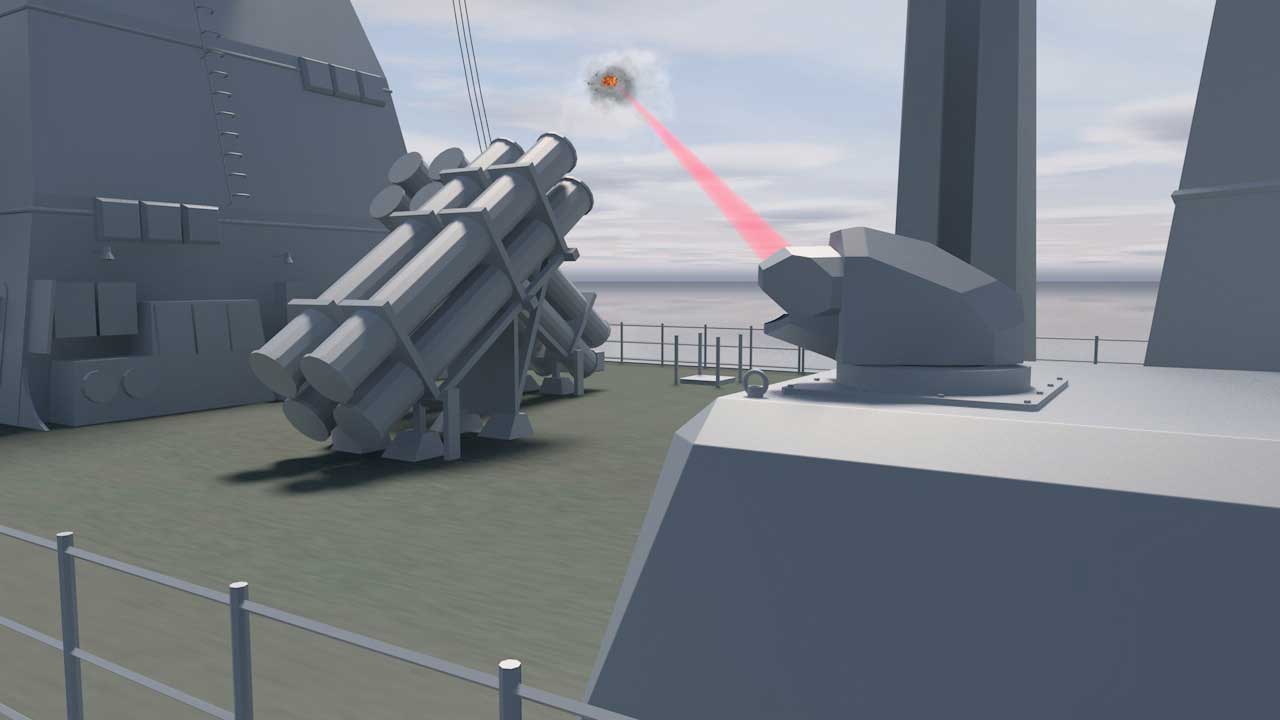Laser Weapon Demonstrator for Naval Frigate
MBDA Deutschland and Rheinmetall Waffe Munition awarded contract for maritime laser weapon demonstrator.
28 January 2021

Laser Weapons
The German Bundeswehr has awarded a contract for the testing of a laser weapon demonstrator on a German naval frigate.
The contract, which is valued in the low double-digit million euro range, was awarded by the Bundeshwehr Equipment, Information Technology and In-Service Support (BAAINBw) to a consortium comprising MBDA Deutschland and Rheinmetall Waffe Munition.
Work will be shared between members of the consortium on a roughly equal basis. MBDA Deutschland is responsible for tracking, the operator’s console and linking the laser weapon demonstrator to the maritime vessel's command-and-control system. Rheinmetall is in charge of the laser weapon station, the beam guiding system, cooling, and integration of the laser weapon system into the project container of the laser source demonstrator. The demonstrator is expected to be completed by the end of this year. Trials onboard the German Navy frigate F124 Sachsen will commence in 2022.
Doris Laarmann, head of laser business development at MBDA Deutschland says the contract is an important step on the path to an operational high-energy laser system. “Once it’s installed, the demonstrator will also be used to test important aspects such as the interaction and function of the sensor suite, combat management system and effector as well as rules of engagement,” she said.
Alexander Graf, head of Rheinmetall Waffe Munition’s laser weapons programme, and Dr Markus Jung, who leads the company’s laser weapon development effort, said the contract marks a systematic extension of the functional prototype laser weapon successfully tested in recent years. The experience gained from that project is now dovetailing into one of the most ambitious projects in the field of laser weapon development in Europe, they said.
Lasers engage targets at the speed of light, operating with great precision and producing very little collateral damage. A demonstrator system featuring these capabilities will soon be put to the test under highly realistic operating conditions onboard a German frigate.
The US has led the development of Directed Energy Weapons (DEW) using lasers. According to the US Department of Defense's fiscal year 2020 budget request, 6% of the total budget ($14 billion in dollar terms) is allocated for science and technology efforts including Directed Energy, the quantum sciences, AI and hypersonics.
All three of the US services— Army, Navy and Air Force — are pushing into DEW in a big way. DEW experimental programmes have been in place across all three services for many years, but efforts are being ramped up as the military endeavours to get these weapons out of the laboratory and into the hands of sailors, soldiers and airmen.
The US Army is moving forward with its “most powerful laser weapon to date,” the 250 to 300 kilowatt Indirect Fires Protection Capability-High Energy Laser (IFPC-HEL), which is 10 times more powerful than similar weapons developed by the Navy, and is designed to defeat multiple threats — unmanned aircraft, cruise missiles, rockets, artillery, and mortars — simultaneously.
US Navy tests saw the USS Portland shoot down a drone using its high-power laser weapon, the Solid State Laser - Technology Maturation (SSL-TM) Laser Weapon System Demonstrator (LWSD), while operating off Pearl Harbor, Hawaii. LWSD is a high-energy laser weapon system demonstrator developed by Northrup Grumman, with system and ship integration and testing led by NSWC Dahlgren and Port Hueneme. Its deployment on a Pacific Fleet ship is the first system-level implementation of a high-energy class solid-state laser. Capt. Karrey Sanders, commanding officer of USS Portland described the SSL-TM LWSD as a new advanced capability for redefining war at sea against a range of threats, including UAVs and armed small craft.
The US Navy is also working on a less powerful laser weapon, the 60 kw High Energy Laser and Integrated Optical-dazzler and Surveillance (HELIOS), which could be installed on destroyers, which have a lower power margin to add in new systems. It is also pursuing an Optical Dazzling Interdictor, which uses lasers to blind or distract enemy craft approaching a US warship.